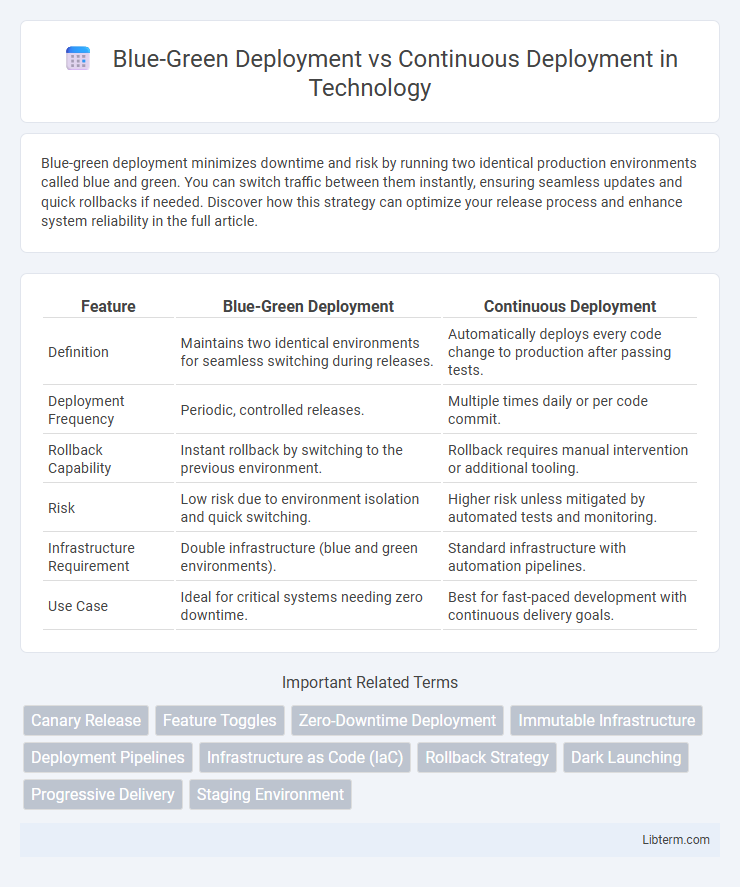Blue-green deployment minimizes downtime and risk by running two identical production environments called blue and green. You can switch traffic between them instantly, ensuring seamless updates and quick rollbacks if needed. Discover how this strategy can optimize your release process and enhance system reliability in the full article.
Table of Comparison
| Feature | Blue-Green Deployment | Continuous Deployment |
|---|---|---|
| Definition | Maintains two identical environments for seamless switching during releases. | Automatically deploys every code change to production after passing tests. |
| Deployment Frequency | Periodic, controlled releases. | Multiple times daily or per code commit. |
| Rollback Capability | Instant rollback by switching to the previous environment. | Rollback requires manual intervention or additional tooling. |
| Risk | Low risk due to environment isolation and quick switching. | Higher risk unless mitigated by automated tests and monitoring. |
| Infrastructure Requirement | Double infrastructure (blue and green environments). | Standard infrastructure with automation pipelines. |
| Use Case | Ideal for critical systems needing zero downtime. | Best for fast-paced development with continuous delivery goals. |
Introduction to Blue-Green Deployment and Continuous Deployment
Blue-Green Deployment is a release management strategy that reduces downtime and risk by running two identical production environments called Blue and Green, where one version serves live traffic while the other is updated and tested before switching. Continuous Deployment automates the entire software release process, enabling code changes to be automatically tested and deployed to production without manual intervention, promoting rapid delivery and feedback. Both strategies aim to improve software reliability and speed but differ in their approach to deployment automation and environment management.
Understanding the Core Concepts
Blue-Green Deployment involves maintaining two identical production environments to minimize downtime and risks by switching traffic between them during releases. Continuous Deployment automates the release process, pushing code changes directly to production as soon as they pass automated tests, emphasizing rapid and frequent delivery. Understanding these core concepts helps organizations balance reliability with speed according to their operational priorities.
How Blue-Green Deployment Works
Blue-Green Deployment works by maintaining two identical production environments: one live (blue) and one idle (green). New application versions are deployed and tested in the green environment while the blue environment serves all live traffic, then traffic is switched to green after successful validation, minimizing downtime and risk. This method ensures seamless updates and quick rollback by simply redirecting traffic back to the previous environment if issues arise.
How Continuous Deployment Operates
Continuous Deployment automates the release process by automatically pushing each code change that passes automated testing directly to production, ensuring rapid and reliable delivery of new features. This approach relies heavily on robust CI/CD pipelines, comprehensive automated tests, and immediate monitoring to detect and resolve issues quickly. By continuously integrating and deploying code, it minimizes manual intervention, reduces deployment risks, and accelerates the feedback loop between development and production environments.
Key Differences Between Blue-Green and Continuous Deployment
Blue-Green Deployment involves maintaining two identical production environments, switching traffic between them to release updates with minimal downtime, whereas Continuous Deployment automates the entire release process, pushing code changes to production frequently and reliably. Blue-Green Deployment emphasizes zero-downtime releases and quick rollback by toggling between blue and green environments, while Continuous Deployment prioritizes rapid, automated delivery and validation of code changes without manual intervention. The key difference lies in Blue-Green's environment management for risk mitigation versus Continuous Deployment's automation focus for speed and continuous delivery of features.
Advantages of Blue-Green Deployment
Blue-Green Deployment minimizes downtime and reduces risk by maintaining two identical production environments, allowing seamless switching between them during updates. This approach enables instant rollback to the previous stable version if issues arise, enhancing service reliability and user experience. It also supports thorough testing in a live environment before full deployment, ensuring higher deployment confidence compared to Continuous Deployment.
Benefits of Continuous Deployment
Continuous Deployment accelerates the software release cycle by automatically deploying every code change that passes automated tests, ensuring rapid delivery of new features and bug fixes. It reduces manual intervention, minimizing human error and enabling faster feedback loops from real users, which enhances product quality and customer satisfaction. This approach increases deployment frequency, supporting agile methodologies and improving overall development efficiency compared to Blue-Green Deployment, which primarily focuses on switchovers between stable environments.
Challenges and Trade-offs of Both Approaches
Blue-Green Deployment requires maintaining two identical production environments, increasing infrastructure costs and complicating database schema changes during switchovers. Continuous Deployment demands robust automated testing and monitoring to prevent faulty releases, posing challenges in ensuring production stability amid frequent updates. Both approaches necessitate balancing deployment speed with reliability, where Blue-Green offers safer rollbacks but higher resource usage, while Continuous Deployment emphasizes agility but requires stringent quality controls.
Use Cases: When to Choose Each Deployment Strategy
Blue-Green Deployment is ideal for applications requiring zero downtime and immediate rollback capabilities, such as e-commerce platforms and critical financial services where availability is paramount. Continuous Deployment suits fast-paced development environments like SaaS products and startups aiming for rapid feature releases and iterative user feedback. Choosing between them depends on the priority of stability versus delivery speed, with Blue-Green providing safer controlled releases and Continuous Deployment enabling frequent updates.
Conclusion: Choosing the Right Deployment Method for Your Team
Selecting the appropriate deployment method hinges on your team's size, risk tolerance, and application complexity. Blue-Green Deployment offers robust rollback capabilities and reduces downtime, ideal for large-scale or high-risk environments. Continuous Deployment accelerates delivery and feedback loops, benefiting agile teams focused on rapid iteration and frequent releases.
Blue-Green Deployment Infographic

 libterm.com
libterm.com